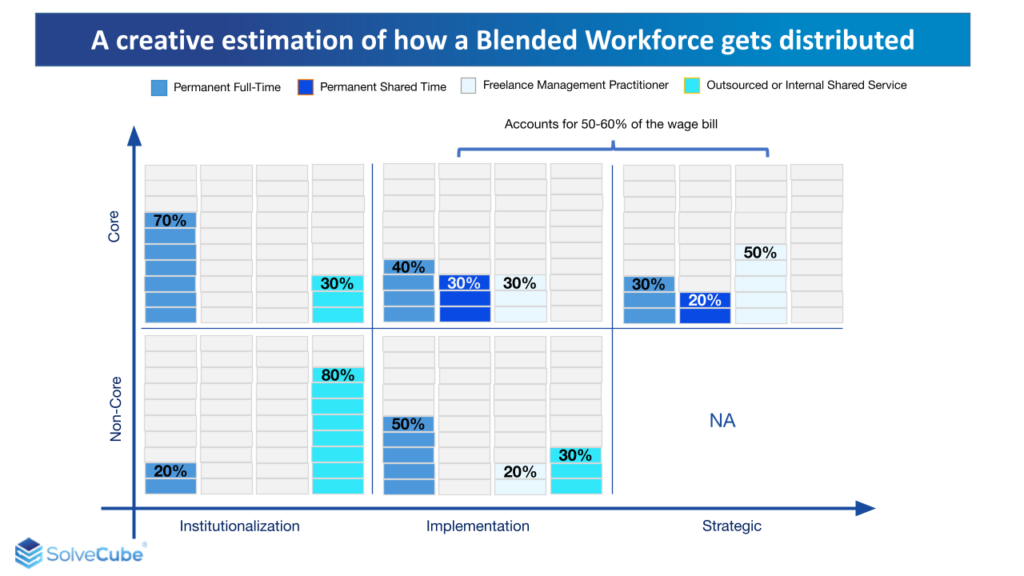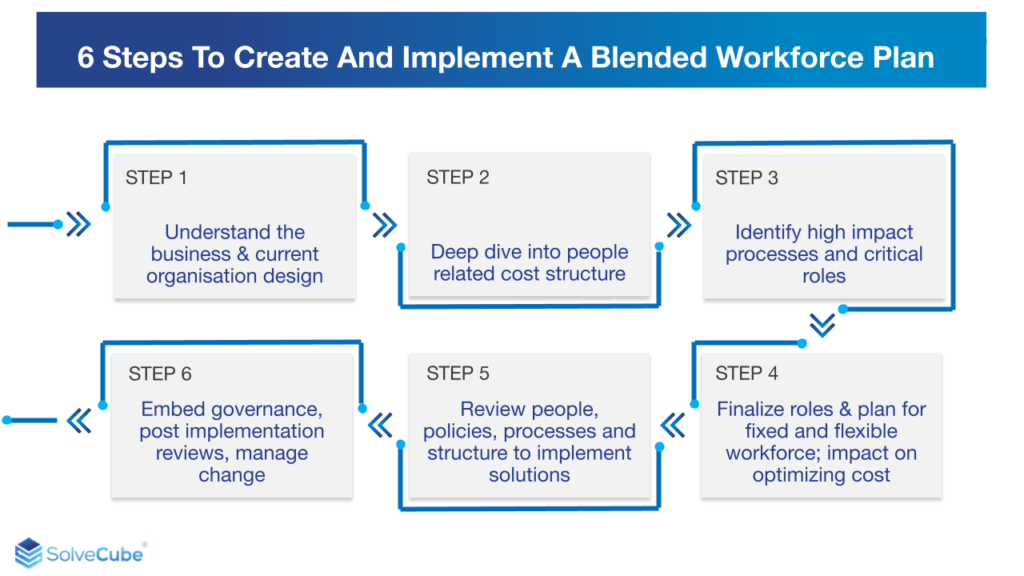It is said that change is the only constant and if the COVID-19 pandemic has taught us anything it is that – acceptance, adaptation, and moving on are the only ways to stay resilient and grow your business.
Nearly two years of ever-changing safety protocols have forced many businesses to change their working style. While location flexibility – the hybrid working pattern – was initially difficult to accept, over time many leaders realized that the only way to withstand constant change is by staying flexible.
The rise of the pandemic has caused the employed to reconsider their relationship with work, and, management to think about business continuation in the face of talent shortages and business losses. While there is rich conversation happening about the benefits and pitfalls of a full work-from-home model, reopening offices, and hybrid work models, these conversations are still largely about the place of work strategy not about workforce strategy.
What is a Blended Workforce Strategy©?
The way we define Blended Workforce Strategy (BWS), is one where the workforce is a blend of different types of domain experts who have varied work contracts with the organization. This type of structure includes permanent full-time, part-time, permanent shared, turnkey freelancers, and outsourced employees working as a single collaborative workforce. This kind of setup works in favor of both, employers as well as employees, as both reap the surplus benefits of this structure.
What are the benefits of a Blended Workforce Strategy© set up?
- Flexible and agile workforce: A glimpse into the traditional talent acquisition practices helps us understand that organizations would often have to recruit experts for a full-time position even if the expertise was not required full-time. The implementation of a blended workforce means that your organization no longer relies on one talent acquisition process. Having a flexible approach toward hiring will increase your chances of discovering highly skilled talent at a more reasonable cost. It also provides the agility needed to adapt workforce skills to keep up with the pace of business change.
- Do away with skill gaps: One of the key takeaways from this setup is an agile workforce that lets employers bring onboard experts needed to speed up work and help them reach their targets, or focus on those prime projects to give them a competitive advantage. This way businesses always have access to top industry experts on demand.
- Specialized and advanced skillset: Some advanced skill sets are expensive to hire permanently. Besides, the need for these non-core skills change based on business strategy and stage of growth. With a blended workforce strategy, full-time permanent employment is no longer required for advanced or super-specialized skills. Hence, organizations can recruit special or advanced skillsets on a retainership basis until they attain the stability they seek.
- Fixed goals and clear communication: By its very nature, a blended workforce setup requires fixed goals and clear channels of communication. This generates efficiency and speeds up progress enabling companies to create high impact and high output.
- Talent inclusion: Traditional workforce strategies have little room for flexible and agile hiring. Companies lose out on expertise simply because they have no strategy that caters to experts who are either challenged by, or, have made a conscious choice based on their stage in life needs. Hiring through AI-powered talent marketplace platforms provides the much-needed access and support required to implement a Blended Workforce Strategy effectively.

Where do you start to create a Blended Workforce Strategy©?
The BWS is about building businesses that are resilient, stay relevant and competitive. So, we start with the business strategy and build a workforce strategy around it. What matters most for HR and business leaders is to use a structured process to peel the layers of job roles, tasks and activities while creating a blueprint for execution. The 6-step process created by ICube is a simple model to work with. Intuitively, a 70:30 ratio of core to non-core workforce should anchor this strategy. However, some industries have higher ratios of 60:40 and 80:20 depending on the type of skills and stage of growth.

Is Blended Workforce Strategy the future for businesses?
As we settle into a new workforce era wherein companies take a more flexible approach to employment, BWS has dual advantages. For one, it helps companies reach their set goals by hiring advanced skillsets based on needs and stage of business growth, as well as overcoming the talent shortage and cost challenges. Secondly, it supports employees ride through their stage of life challenges, promoting well-being, and productivity. Furthermore, it is no secret that the increased use of technology has shifted focus from administrative skills to cognitive and creative problem-solving skills. McKinsey Global Institute recently reported that by 2025, “online talent platforms could increase global GDP by $2.7 trillion and improve job outcomes for 540 million people.” (Cite here)
The pandemic has led businesses to discover what is important for them to stay resilient. What comes up on top is adaptability, adoption of technology, and the appropriate deployment of people skills and experience.
Some part of this blog was published as Blended Workforce – Changing Mindset in Asia Pacific in ecosystem360, Dec 2020.
Blended Workforce Strategy© iCube Consortium Pte. Ltd. August 2019
Please visit us at https://solvecube.com/ to know more.
